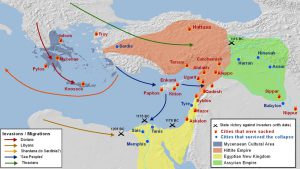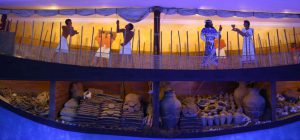Cities are simply destined to fail. They face the same problems over and over again throughout history. Yet today, many rarely tend to think or believe that our system of cities is at any risk of collapse. However, studying history can give rare insights into both what has already happened in the past and what will inevitably happen in the future.
The Bronze Age Collapse of the 12th century BC can be compared to the decline of the Rust Belt today. The Rust Belt of the United States’s Midwest and Great Lakes regions faces severe depopulation, deindustrialization, and de-urbanization. As the industrial heartland saw its manufacturing jobs moved overseas, steel and coal industries declined, and automation increased, the region has spiraled into severe decline.
The Bronze Age Collapse was a regional breakdown of societal order and depopulation of the Aegean, Anatolia, the Levant, Mesopotamia, and Egypt. Many theories and arguments have been put forth for the cause of the Bronze Age Collapse. From natural disasters such as volcanoes and earthquakes to droughts to invading armies, there is not a definite reason for the collapse. Regardless, the Bronze Age featured several parallels to our modern world.

The map above shows the multiple invasions that rocked the Eastern Mediterranean during the late Bronze Age. However, despite the immense destruction of the cities, note the cities that were able to survive the collapse.
The civilizations of the Mycenaean, Hittites, and Egyptians featured interdependent trade among each other. For example, the Uluburun shipwreck of the late 14th century BC showed the transport of goods as it circled the eastern Mediterranean, especially copper and tin ingots, precursors to bronze. Likewise, today’s world is reliant on a system of global trade. In addition, each civilization depended too heavily on bronze for their armies and warrior aristocracy, and as a means to trade for other goods. The very same bronze, as important as crude oil today, whose need of tin, required imports from as far as modern-day Great Britain. This compares to the Rust Belt whose overreliance on manufacturing and its industry to power its economy. The importance of bronze and industry respectively in their systems meant that even a minor disruption can have enormous impacts.

A side-view replica of the Uluburun shipwreck details the exhaustive collection of goods held by the ship as its voyage circled the Eastern Mediterranean.
However, both histories show that collapse is not inescapable. Several Rust Belt cities have found success by shifting away from manufacturing and diversifying their economies with service industries, higher education, and more specialized industries. Similarly, not all cities met their end during the end of the Bronze Age. Several cities adapted to the changing times either by giving up their overreliance on bronze or simply moving away from the torrent of disasters, droughts, and invaders.
The inability of the systems to adapt to new problems is what led to the collapse of the Bronze Age. And likewise, should the Rust Belt cities continue to believe that manufacturing can make a comeback, they will repeat history. The lessons of the Bronze Age Collapse teach us that although we can handle better our problems, we cannot afford to be reliant on a single form of living or to be afraid to adapt.
Works Cited:
Austin, John C. 2017 A tale of two Rust Belts. The Avenue (blog), December 5, 2017. http://www.brookings.edu/blog/the-avenue/2017/12/05/a-tale-of-two-rust-belts, accessed November 4, 2018.
Porter, Eduardo 2018 Lessons from Rust-Belt Cities That Kept Their Sheen. New York Times 1 May. New York.
The Human Journey. Ideas that Shaped our Modern World: Connecting with the Gods, The Bronze Age Collapse. http://www.humanjourney.us/ accessed November 4, 2018.
Image Sources:
Historical Atlas of the Mediterranean. The Bronze Age Collapse (1250-1150 BC) http://explorethemed.com/ accessed November 4, 2018.
The Human Journey. Ideas that Shaped our Modern World: Connecting with the Gods, The Bronze Age Collapse. http://www.humanjourney.us/ accessed November 4, 2018.
Further Reading:
Cline, Eric H 2014 1177 B.C.: The Year Civilization Collapsed. Princeton University Press, Princeton.
Millsap, Adam 2017 The Rust Belt Didn’t Adapt And It Paid The Price. Forbes 19 Jan. Jersey City.

You give a good analysis of the rust belt and the Bronze Age and their similarities using history. What can archaeology of these areas tell us about their similarities and how they have risen/fallen?
Delving deeper into the archaeology of the Late Bronze Age reveals more about both the effect of climate change and the human response. Pollen analysis of the Late Bronze Age revealed a dry period in the Southern Levant (Langgut 2013). As the continuous dry years compounded, crops failed and grazing opportunities decreased. As food prices rose without relief in sight, people migrated away in search of food. This rapid movement of human population then led to instability across the region, followed by a collapse of trade networks and states.
A similar pattern can be found regarding population migration in the Rust Belt. Following decreases in economic opportunities, particularly, in manufacturing, the Rust Belt states have reported a net loss in population for the past decades. While this pattern is not as chaotic as the Bronze Age, the two perspectives support an important pattern of human history, where people are forced to adapt to changes in their environment. Looking at the two areas of history, we learn that people must either adapt to new conditions or not survive.
Dafna Langgut, Israel Finkelstein & Thomas Litt (2013) Climate and the Late Bronze Collapse: New Evidence from the Southern Levant, Tel Aviv, 40:2, 149-175, DOI: 10.1179/033443513X13753505864205